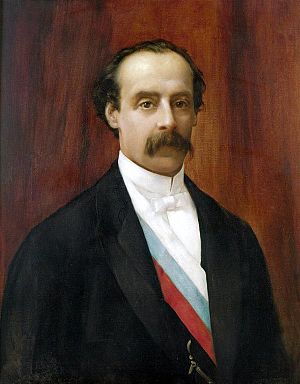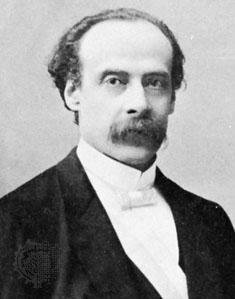José Manuel Balmaceda facts for kids
Quick facts for kids
José Manuel Balmaceda
|
|
|---|---|

Portrait by Fernando Laroche, 1891
|
|
| 10th President of Chile | |
| In office September 18, 1886 – August 29, 1891 |
|
| Preceded by | Domingo Santa María |
| Succeeded by | Manuel Baquedano |
| Personal details | |
| Born | July 19, 1840 Hacienda Bucalemu, Chile |
| Died | September 19, 1891 (aged 51) Santiago, Chile |
| Political party | Liberal |
| Spouse | Emilia de Toro Herrera |
| Signature | |
José Manuel Emiliano Balmaceda Fernández (July 19, 1840 – September 19, 1891) was the 10th President of Chile. He served from September 18, 1886, to August 29, 1891. Balmaceda came from an important and wealthy family in Chile. During his time as president, he had many disagreements with the Chilean Congress. These disagreements eventually led to the 1891 Chilean Civil War. After the war, his life ended on September 19, 1891.
Contents
Early Life and Education
José Manuel Balmaceda was born in Bucalemu, Chile. He was the oldest of 12 children. His parents, Manuel José Balmaceda Ballesteros and Encarnación Fernández Salas, were very wealthy. When he was young, he was interested in business and farming.
In 1849, he went to the School of the French Friars. He even thought about becoming a priest and studied theology for several years.
Starting a Political Career
In 1864, Balmaceda became a secretary for Manuel Montt. Montt was a Chilean government representative at a big meeting in Lima, Peru. When Balmaceda returned, he became known as a great speaker in the national assembly.
In 1868, he helped start a newspaper called "La Libertad" (meaning Freedom). He also wrote for another magazine and published two important papers. In 1869, he joined a group called the Club de la Reforma. This group later became the basis for the Liberal Party.
The Liberal Party wanted several important changes. They believed in freedom of religion and more personal and political freedom. They also wanted to stop the government from interfering in elections. They aimed to change the 1833 constitution and limit the president's powers.
Balmaceda was elected as a Deputy (a type of representative) for Carelmapu many times. He served from 1864 to 1882.
Diplomacy and Government Roles
Under President Aníbal Pinto, Balmaceda worked on some diplomatic missions abroad. He is known for convincing Argentina not to join the War of the Pacific in 1878.
In 1882, he was elected again for two different areas, but he chose not to take either seat. Instead, he became the Minister of Foreign Affairs and later the Minister of the Interior. He served under President Domingo Santa María. In these roles, he introduced new laws that some people, especially religious groups, didn't like. For example, he made civil marriage (marriage without a religious ceremony) mandatory.
Balmaceda was also elected as a Senator for Coquimbo from 1882 to 1888. On January 17, 1886, he was announced as a candidate for president. He had support from several political parties. On June 25, he was elected president without any other candidates running against him.
Balmaceda's Presidency
José Manuel Balmaceda became President of Chile in 1886. His election faced strong opposition from some groups. When he took office, he tried to unite all parts of the Liberal Party. He wanted to create a strong majority in Congress to support his government. He appointed ministers from different political groups to achieve this.
However, Balmaceda's strong personality sometimes made it hard for him to work with others. He believed he had enough support in Congress to make big changes. He started a huge plan to spend a lot of money on public projects. This included building schools and making the Navy and Army stronger.
Big Public Projects
Balmaceda approved contracts worth a lot of money to build railways in the southern parts of Chile. Millions of dollars were spent on building new schools and colleges. The Navy got three new cruisers and two torpedo boats. Work on the naval port at Talcahuano moved forward quickly. New weapons were bought for the Army, and strong guns were placed to protect the ports of Valparaíso, Talcahuano, and Iquique.
These projects were meant to help the country grow. However, some problems arose. There were reports of corruption, where contracts were given based on favoritism, not on who could do the best work. The progress on some projects was also slow.
By late 1887, more and more people in Congress started to oppose President Balmaceda. This opposition grew even stronger in 1888. To try and get more support, the President tried to influence the elections for Senators and Deputies in 1888. But many of the people elected through his influence later joined the opposition.
Growing Conflict with Congress
By 1889, Congress was clearly against President Balmaceda's government. The political situation became very serious and sometimes threatened to cause a civil war. In Chile, it was customary for a group of ministers (called a ministry or cabinet) to stay in office only if they had the support of most members of Congress.
Balmaceda found it difficult to appoint ministers that both Congress would approve and who would also support his policies. At this point, the President believed that the constitution gave him the power to choose any ministers he wanted. He thought Congress had no right to interfere.
Congress was waiting for a chance to show its power. In 1890, it was said that President Balmaceda planned to choose one of his personal friends to be his successor in 1891. This issue made things even worse. Congress refused to approve money for the government to operate.
To avoid more trouble, Balmaceda made a deal with Congress. He agreed to appoint ministers that Congress liked, if they would approve the money for 1890. However, this new group of ministers did not last long. They resigned when they saw how much conflict there was between the President and Congress.
Balmaceda then appointed a new group of ministers that Congress did not agree with. This group was led by Claudio Vicuña, who Balmaceda clearly wanted to be the next president. To stop Congress from discussing his actions, Balmaceda did not call a special meeting of the legislature to approve the budget for 1891.
The Chilean Civil War of 1891
On January 1, 1891, the president announced that the budget from 1890 would be used for 1891. This action was against the law and went beyond the president's powers.
In response, the vice-president of the Senate, Waldo Silva, and the president of the Chamber of Deputies, Ramón Barros Luco, made an announcement. They named Captain Jorge Montt as the commander of the Navy. They stated that the Navy would not recognize Balmaceda's authority unless he followed Chile's constitutional laws. Most members of Congress supported this decision. They signed a document removing President Balmaceda from power.
On January 7, Waldo Silva, Barros Luco, and many senators and deputies boarded Chilean warships. They sailed north to Tarapacá to organize armed resistance against the president. This marked the beginning of the civil war.
The conflict was not just about Balmaceda's actions against Congress. Balmaceda had also upset the wealthy and powerful families of Chile. He tried to govern without their support. He brought new people into the government who were outside the usual political circles. These new people were easier for him to control. Religious leaders also turned against him because of his ideas about separating government from religious influence.
Some reports from the time, like one from a London newspaper correspondent, suggested that British interests played a role in the overthrow of Balmaceda. This was because of British ownership of nitrate mines in the Tarapacá region.
End of the Presidency and Life
Balmaceda's forces were defeated in the Battle of La Placilla. It became clear that he could no longer stay in power. As the rebel army approached, he left his official duties and sought safety in the Argentine embassy. On August 29, he officially gave power to General Manuel Baquedano. Baquedano kept order in Santiago until the congressional leaders arrived on August 30.
The president stayed hidden in the Argentine embassy until September 19. On that morning, one day after the anniversary of becoming president and when his term officially ended, he died. He chose not to surrender to the new government. In letters he wrote before his death, he explained that he did not believe he would get a fair trial from the new government. Balmaceda's death ended the conflict in Chile. It was the final act of the most difficult and bloody struggle the country had ever seen.
Family Life
On October 11, 1865, Balmaceda married Emilia de Toro Herrera. She was the granddaughter of Mateo de Toro Zambrano, 1st Count of La Conquista. They had eight children together, and six of them lived to adulthood:
- María Emilia del Carmen (born July 14, 1866)
- Domingo Nicolás (born September 14, 1870)
- Pedro Alberto José (April 23, 1868–1889), who was a poet and writer, died at age 21
- María Elisa (born March 24, 1873), who married Emilio Bello Codesido
- Julia (born May 10, 1874)
- María Catalina (November 6, 1875–1967)
- Enrique Víctor Aquiles (March 3, 1878 – January 4, 1962), who became a Chilean diplomat
- José Manuel (born March 13, 1882)
Images for kids
See also
 In Spanish: José Manuel Balmaceda para niños
In Spanish: José Manuel Balmaceda para niños






